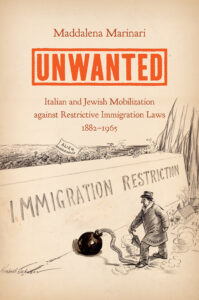
Professor Maddalena Marinari
Gustavus Adolphus College history professor Maddalena Marinari’s new book, Unwanted: Italian and Jewish Mobilization against Restrictive Immigration Laws, 1882-1965, delves into the United States’ often complicated relationship with immigration policy and the effects that those policies have on different ethnic and national groups. Published by the University of North Carolina Press, the book is Maddalena’s historical account of the experience of Italian and Jewish immigrants as they “tested the limits of citizenship and citizen activism” in the early 20th century.
Unwanted paints a picture of historical immigration trends and legislation that have continued to shape policy and rhetoric today in the U.S. and beyond. As the book hit shelves, Maddalena took a break from her work this semester as a DAAD (German Academic Exchange Service) visiting professor at the University of Kassel (Germany) to answer the following questions…
 Q: How does studying immigration from a historical perspective help us understand today’s complicated immigration and refugee situation across the globe?
Q: How does studying immigration from a historical perspective help us understand today’s complicated immigration and refugee situation across the globe?
A: History builds on itself. We are where we are today because of what has happened in the past two centuries of immigration policy. The rise of nation states led to increasingly intense efforts to control who enters a country, determine what the ideal immigrant looks like, and reject anyone who is perceived as a social, cultural, or political threat. The United States, for example, has never welcomed all immigrants, but, starting at the end of the 19th century, it passed increasingly restrictive immigration laws that targeted immigrants for their sexual orientation, economic status, political beliefs, ability, and potential. In 1924, the United States instituted a system of quotas that determined how many immigrants could come from countries in the Eastern Hemisphere to limit the arrival of Italians and Eastern European Jews, among others. The same law also banned most immigrants from Asia simply because they were not white and denied the right to naturalize to Asian immigrants who were already in the United States. The U.S. Congress also created the Border Patrol in 1924 and passed measures targeting migrants in Latin America, even though they were technically exempted from the quota system. These legislative developments paved the way for many of the restrictions imposed against immigrants and refugees today. They also made it acceptable to deny entry to victims fleeing persecution or to blame immigrants for any social, economic, or political changes affecting the country. Then, like now, developments in the United States influenced what countries around the world did. Many of them passed similar laws, collaborated with the United States when it came to enforcement, and adopted a similar anti-immigrant rhetoric.
Q: Your book delves into the mobilization of Italian and Jewish reformers against U.S. immigration laws that targeted them. What means of advocacy did those groups use that were particularly effective in advancing their cause?
A: Italian and Jewish reformers, along with activists representing other immigrant groups targeted for restriction, tested and re-tested numerous strategies to challenge discriminatory immigration laws. Many of their strategies are still used today, but, at the time, they were not sure which ones would be most effective. They went to court, wrote popular books and articles showing immigrants’ contributions to the United States, and launched nationwide educational campaigns challenging the stereotypes that Americans had of them as undesirable. They believed that if many Americans knew more about them, they would stop denigrating them and join them in their fight for a more humane immigration policy. Ultimately, however, these strategies had a limited impact. What worked for them was to put pressure on legislators themselves and the executive branch to convince them to carry out specific reforms. While they did not always succeed in getting wholesale reform, they managed to challenge several of the more restrictive provisions of U.S. immigration policy in the middle of the 20th century, especially when it came to family reunion.
Q: How does your research inform your teaching? In what ways do undergraduates at Gustavus benefit from an understanding of immigration history?
A: All of my courses, in one way or another, deal with immigration history because immigration is central to the history of the United States. I draw from my research to question some of the longstanding myths about immigration to the United States. The United States has long claimed to be a “Nation of Immigrants,” but it’s important for students to know the history behind this idea and grapple with the fact that the United States has never been, in fact, a country open to all immigrants. Understanding this helps students reflect on what it means to be an American, who belongs, and how immigration laws have been used to shape U.S. society. My research not only informs how I teach because it helps me give students specific example from my scholarship to illustrate critical developments in U.S. history, it also allows me to work more effectively with students when they are working on their own research projects. I can draw from my personal experience to help them frame a research question, look for sources, organize their research, or simply get the writing done. I can also demystify many of the myths that students have about writing history.
Q: What are the key takeaways from Unwanted?
A: The book shows how difficult it is to change course when it comes to immigration. While the people at the center of my book were ultimately successful in pushing for the repeal of some of the most discriminatory features of U.S. immigration policy passed by 1924, the 1965 Immigration and Naturalization Act was hardly perfect. In the long run, it created new problems for immigrants who came after 1965. This is because, in the racial landscape of the United States, it is very difficult to create interethnic coalitions where every immigrant group feels heard and represented. Moreover, the political system that emerged at the beginning of the 20th century, with its emphasis on committees and seniority, made it virtually impossible to fight for wholesale reform. Italian and Jewish activists understood early on that family reunion was the only issue restrictionist legislators were willing to negotiate on, but that meant that they had to forego reforming other equally important restrictions, particularly those targeting immigrants who were not highly skilled or educated. Finally, my book shows how central war is in the making and unmaking of U.S. immigration policy, something that few scholars have paid attention to. While supporters of immigration restriction successfully used WWI to push for harsher immigration laws, critics of immigration restriction used WWII to push for the first of many small changes to the most draconian immigration policy passed in U.S. history until then.
###
Media Contact: Director of Media Relations and Internal Communication Luc Hatlestad
luch@gustavus.edu
507-933-7510